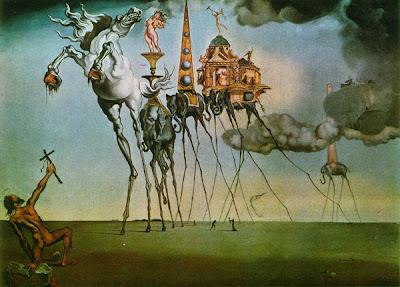The Catcher in the Rye
Knowingly borrowing from the works of well known or forgotten artists is really an attractive staff. Salvador Dalí can be a very good example for that research. He knew very well the value of a good idea, which was not yet in the central focus of mass culture conscious.
There is a story about a temptations of hermit Anthony, first written by Athanasius of Alexandria. This experience represents an irresistible life challenge for certain people, which cannot be rejected. The story went through countless interpretations. One of the most incredible experience is awaiting you in the book "Temptation of st. Anthony" written by Gustave Flaubert. This surrealistic typhoon stirred my waters about fifteen years ago, when I was living in my hermitage of wood. I got intoxicated by this unusual text during deep nights – I did not experience any religious shock – just the touch of the Flaubert's phenomenon made me shivering and shaking and caused birth of new horizons somewhere deep inside of my rising universe.
But, to stay in the trays of the topic, the opportunity to substantiate the wondrous Anthony's experience tempted many masters of brush and colour. One of them was Salvator Rosa, whose monsters attacking the lonely hermit have quite temporary look.
Salvator Rosa, Temptation of st. Anthony, 1646
Three centuries later a painting with the same subject and features was created by a painter with the same first name. You can discover there an interesting idea of Rosa, which immediately became an ace of spades in the hands of master Dalí. 
Salvador Dalí, Temptation of st. Anthony, 1946, detail
The general view of the painting discloses the power of imagination of the very specific Spaniard, producing new and new variations exploiting the unnoticed detail, lying bare several centuries. But the little spark inside the right head can cause unexpected fire.

































